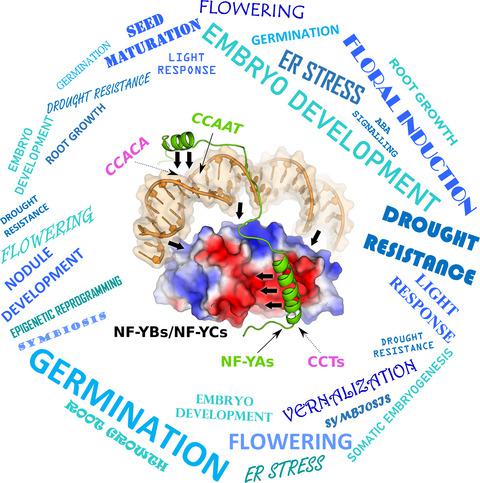Our official English website, www.x-mol.net, welcomes your
feedback! (Note: you will need to create a separate account there.)
Structural determinants for NF‐Y subunit organization and NF‐Y/DNA association in plants
The Plant Journal ( IF 6.2 ) Pub Date : 2020-10-24 , DOI: 10.1111/tpj.15038 Antonio Chaves‐Sanjuan 1 , Nerina Gnesutta 1 , Andrea Gobbini 1 , Damiano Martignago 1 , Andrea Bernardini 1 , Fabio Fornara 1 , Roberto Mantovani 1 , Marco Nardini 1
The Plant Journal ( IF 6.2 ) Pub Date : 2020-10-24 , DOI: 10.1111/tpj.15038 Antonio Chaves‐Sanjuan 1 , Nerina Gnesutta 1 , Andrea Gobbini 1 , Damiano Martignago 1 , Andrea Bernardini 1 , Fabio Fornara 1 , Roberto Mantovani 1 , Marco Nardini 1
Affiliation

|
NF‐Y transcription factor comprises three subunits: NF‐YA, NF‐YB and NF‐YC. NF‐YB and NF‐YC dimerize through their histone fold domain (HFD), which can bind DNA in a non‐sequence‐specific fashion while serving as a scaffold for NF‐YA trimerization. Upon trimerization, NF‐YA specifically recognizes the CCAAT box sequence on promoters and enhancers. In plants, each NF‐Y subunit is encoded by several genes giving rise to hundreds of potential heterotrimeric combinations. In addition, plant NF‐YBs and NF‐YCs interact with other protein partners to recognize a plethora of genomic motifs, as the CCT protein family that binds CORE sites. The NF‐Y subunit organization and its DNA‐binding properties, together with the NF‐Y HFD capacity to adapt different protein modules, represent plant‐specific features that play a key role in development, growth and reproduction. Despite their relevance, these features are still poorly understood at the molecular level. Here, we present the structures of Arabidopsis and rice NF‐YB/NF‐YC dimers, and of an Arabidopsis NF‐Y trimer in complex with the FT CCAAT box, together with biochemical data on NF‐Y mutants. The dimeric structures identify the key residues for NF‐Y HFD stabilization. The NF‐Y/DNA structure and the mutation experiments shed light on HFD trimerization interface properties and the NF‐YA sequence appetite for the bases flanking the CCAAT motif. These data explain the logic of plant NF‐Y gene expansion: the trimerization adaptability and the flexible DNA‐binding rules serve the scopes of accommodating the large number of NF‐YAs, CCTs and possibly other NF‐Y HFD binding partners and a diverse audience of genomic motifs.
中文翻译:

植物中NF-Y亚基组织和NF-Y / DNA结合的结构决定因素
NF-Y转录因子包含三个亚基:NF-YA,NF-YB和NF-YC。NF-YB和NF-YC通过其组蛋白折叠结构域(HFD)进行二聚化,该结构域可以以非序列特异性方式结合DNA,同时用作NF-YA三聚化的支架。三聚化后,NF-YA特异性识别启动子和增强子上的CCAAT盒序列。在植物中,每个NF-Y亚基由几个基因编码,从而产生数百种潜在的异源三聚体组合。此外,作为结合CORE的CCT蛋白家族,植物NF-YB和NF-YC与其他蛋白质伴侣相互作用以识别过多的基因组基序。网站。NF-Y亚基的组织及其DNA结合特性,以及NF-Y HFD适应不同蛋白质模块的能力,代表了植物特有的特征,这些特征在发育,生长和繁殖中起着关键作用。尽管它们具有相关性,但在分子水平上仍然对这些特征了解甚少。在这里,我们介绍了拟南芥和水稻NF-YB / NF-YC二聚体的结构,以及与FT CCAAT盒复合的拟南芥NF-Y三聚体的结构,以及有关NF-Y突变体的生化数据。二聚体结构确定了NF-Y HFD稳定化的关键残基。NF-Y / DNA结构和突变实验揭示了HFD三聚体界面特性和NF-YA序列对侧翼碱基的食欲。CCAAT主题。这些数据解释了植物NF-Y基因扩增的逻辑:三聚化适应性和灵活的DNA结合规则为适应大量NF-YA,CCT以及可能的其他NF-Y HFD结合伙伴和多样化受众提供了范围基因组图案。
更新日期:2020-10-24
中文翻译:

植物中NF-Y亚基组织和NF-Y / DNA结合的结构决定因素
NF-Y转录因子包含三个亚基:NF-YA,NF-YB和NF-YC。NF-YB和NF-YC通过其组蛋白折叠结构域(HFD)进行二聚化,该结构域可以以非序列特异性方式结合DNA,同时用作NF-YA三聚化的支架。三聚化后,NF-YA特异性识别启动子和增强子上的CCAAT盒序列。在植物中,每个NF-Y亚基由几个基因编码,从而产生数百种潜在的异源三聚体组合。此外,作为结合CORE的CCT蛋白家族,植物NF-YB和NF-YC与其他蛋白质伴侣相互作用以识别过多的基因组基序。网站。NF-Y亚基的组织及其DNA结合特性,以及NF-Y HFD适应不同蛋白质模块的能力,代表了植物特有的特征,这些特征在发育,生长和繁殖中起着关键作用。尽管它们具有相关性,但在分子水平上仍然对这些特征了解甚少。在这里,我们介绍了拟南芥和水稻NF-YB / NF-YC二聚体的结构,以及与FT CCAAT盒复合的拟南芥NF-Y三聚体的结构,以及有关NF-Y突变体的生化数据。二聚体结构确定了NF-Y HFD稳定化的关键残基。NF-Y / DNA结构和突变实验揭示了HFD三聚体界面特性和NF-YA序列对侧翼碱基的食欲。CCAAT主题。这些数据解释了植物NF-Y基因扩增的逻辑:三聚化适应性和灵活的DNA结合规则为适应大量NF-YA,CCT以及可能的其他NF-Y HFD结合伙伴和多样化受众提供了范围基因组图案。











































 京公网安备 11010802027423号
京公网安备 11010802027423号